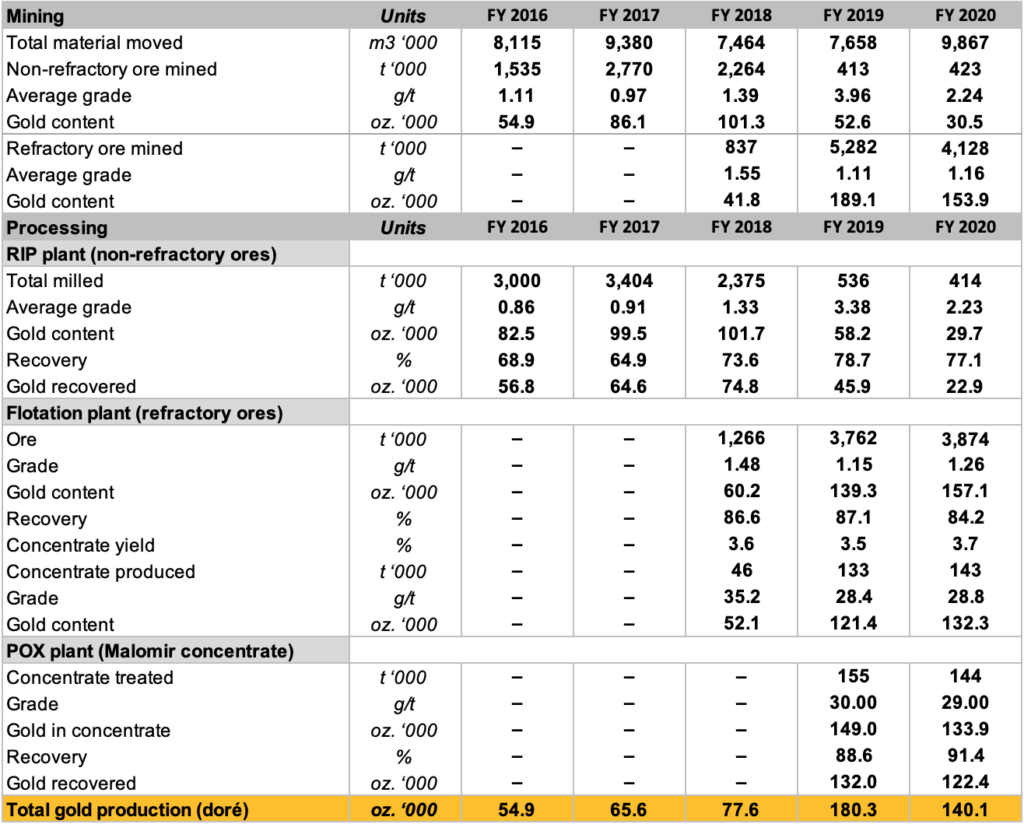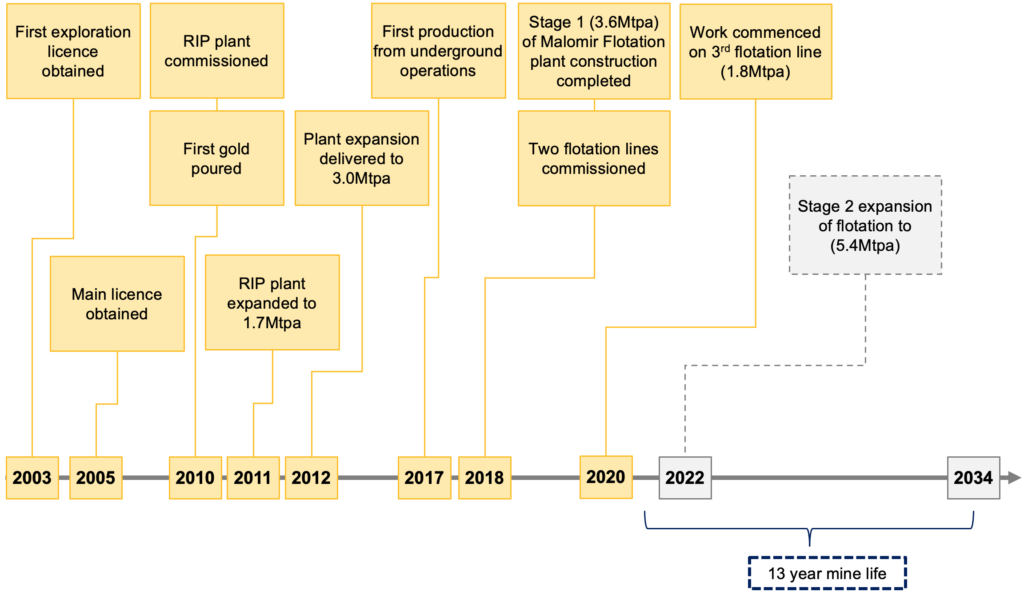Malomir
Key facts
| Location | 670km north-east by road of Pokrovskiy (location of POX Hub)
Accessed by all year road, with rail head 166km away |
|---|---|
| History | Acquired as a greenfield licence in 2003
First production 2010, c.1.1Moz gold produced as of FY 2020 |
| Licence type/status | 2 licences, valid until 2030 – 2033 |
| Mining method | Conventional open pit + underground mine |
| Mineralisation type | Orogenic-type refractory gold deposit |
| Processing circuit | RIP for non-refractory + flotation for refractory |
| Plant capacity | 0.4Mtpa RIP + 3.6Mtpa flotation |
| 2020 Recovery | RIP 77%, Flotation 84%, POX 91% |
| JORC Ore Reserves(1) |
0.04Moz non-refractory (1.82g/t) 2.30Moz refractory (0.97g/t) |
| JORC Ore Resources(1) |
0.08Moz non-refractory (2.15g/t) 3.80Moz refractory (0.87g/t) |
| Workforce | c.1,280 |
| Power | National grid |
(1) As of 31 December 2020. Mineral Resources shown as Measured & Indicated, inclusive of Ore Reserves
At a glance statistics

Overview

Malomir was acquired as a greenfield project in 2003 and is considered by Management to be one of Russia’s largest gold mines in terms of its Mineral Resource base. In FY 2018, Malomir’s production accounted for 18% of total Group gold production, rising to 35% in FY 2019 due to the ramp-up of the POX Hub.
Mining takes place predominantly in Central open pit with smaller amount of ore extracted from Quartzitovoye and Magnetitovoye pits. A smaller underground mining operation begun at Quartzitovoye from January 2017.
As at 31 December 2020, Malomir’s Ore Reserves were estimated to be 2.34Moz, of which 98% are refractory, making the mine one of the key potential suppliers of refractory gold to the POX Hub. As of 31 December 2020, Malomir had produced approximately 1.1Moz of gold since commissioning in mid-2010. In Q1 2021, Malomir produced approximately 36.0Koz.

Operations
Mining at Malomir is carried out as both open pit and underground operations. The Group operates its own mining fleet for exploiting the open pit and is assisted by a local contractor. Underground mining is performed by a reputable Russian underground mining contractor. Mining productivity and equipment utilisation is optimised by operating two shifts daily throughout the year.

Higher-grade non-refractory ore extracted from Quartzitovoye underground and Magnetitovoye open pit is processed at the 0.4Mtpa RIP plant which is operational throughout the year. The refractory ore from Malomir Central pit is treated at the 3.6Mtpa flotation plant before being sent for final processing through the POX plant at Pokrovskiy c.670km (by motor road) from Malomir.
Stage I of the flotation plant (3.6Mtpa) became fully operational from October 2018 and the Company is undertaking a feasibility study to consider a second stage expansion to 5.4Mtpa to maximize utilisation of capacity at the POX Hub. The flotation plant removes carbon and converts refractory ore into higher- grade refractory concentrate prior to being sent to the POX Hub.
Underground development commenced at Malomir’s Quartzitovoye zone in January 2017.

(1) Discrepancies between gold recovered and gold produced is a function of gold recovery from the processing circuit.
Geology
Malomir is situated along and above a major thrust zone within the Mongolo-Okhotskiy mineralised belt. The gold-bearing ore body is hosted by upper Palaeozoic metasediments, mainly carbonaceous shales, which are affected by low-grade regional metamorphism and locally intense metasomatic alteration with associated hydrothermal mineralisation.
Malomir is the most significant known orebody within the Malomir licence. The principal zone of mineralisation has a tabular morphology with strike length of 4.2km and down dip extension up to 1.5km. The typical thickness of this zone within the pit design is 20 to 30m and up to 100m in some places. It is found above shallow-dipping thrust zone which dips at 15-20° in a northern direction.
In addition to the principal zone, there are many smaller more steeply-dipping zones situated above the main zone. The Malomir orebody is refractory, suitable for the flotation and POX processing route.
Quartzitovoye is the other significant orebody within the project. It comprises of high-grade steep dipping zones 55 and 49 as well as low grade stockwork style mineralisation. The high-grade zones are non-refractory and they remain open in down dip direction, with potential to increase non-refractory resources for potential underground mining.
Ozhidaemoye is an eastern extension of Malomir with a similar tabular morphology and shallow dip towards north. Ozhidaemoye is refractory and expected to provide ore for flotation and the POX plant.
History
Malomir was acquired by the Group as a greenfield site in 2003. Following several years of exploration and undertaking feasibility studies, the first RIP plant was commissioned in 2010 which was expanded a year later to 1.7Mtpa and then again to 3.0Mtpa in 2012. In 2020, work commenced on stage 2 construction of flotation plant which will bring total capacity to 5.4Mtpa. The construction of a third line at the Malomir flotation plant remains on track and will add an additional 1.8Mtpa of flotation capacity from Q3 2022.


